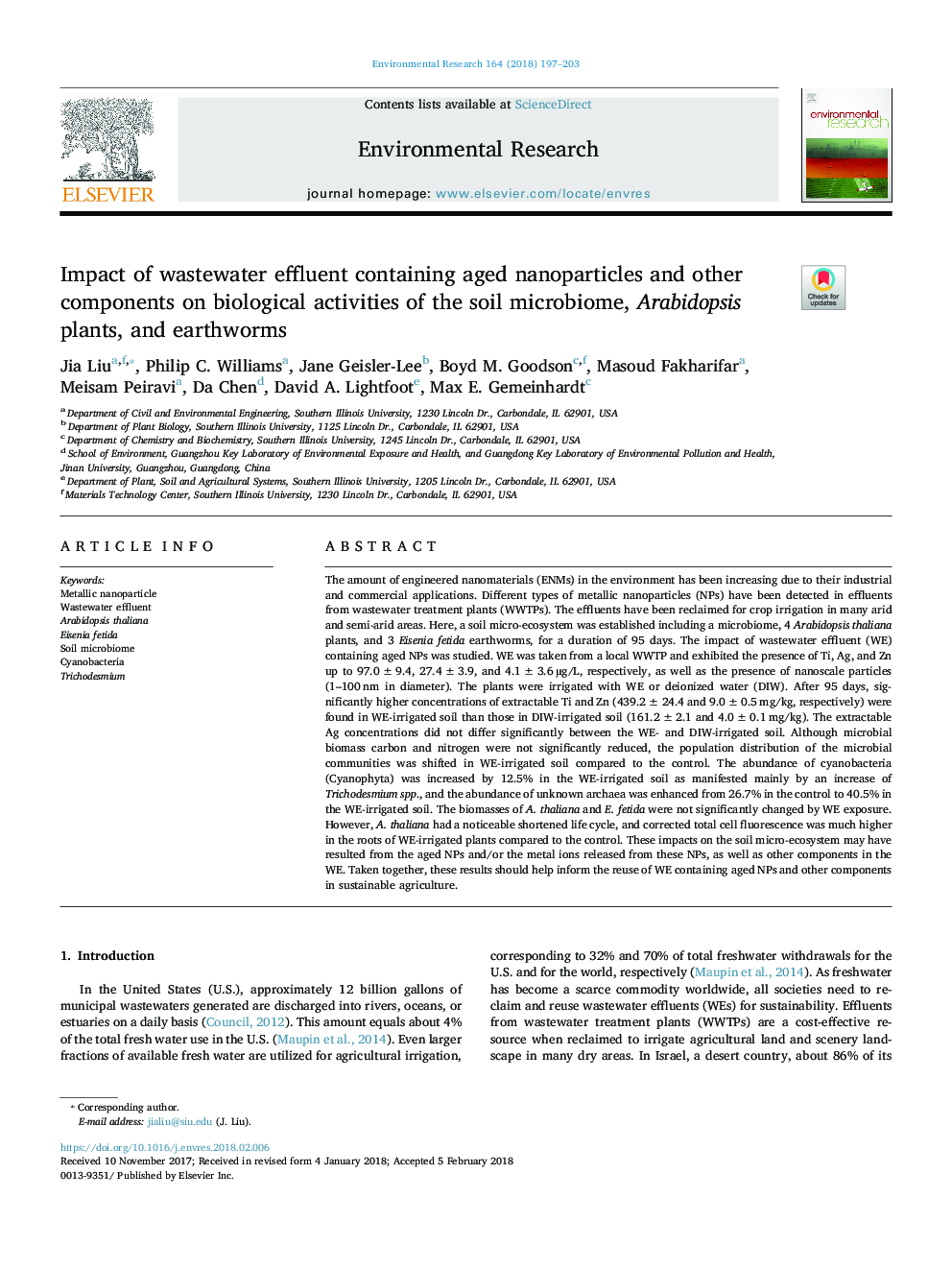| کد مقاله | کد نشریه | سال انتشار | مقاله انگلیسی | نسخه تمام متن |
|---|---|---|---|---|
| 8869075 | 1622539 | 2018 | 7 صفحه PDF | دانلود رایگان |
عنوان انگلیسی مقاله ISI
Impact of wastewater effluent containing aged nanoparticles and other components on biological activities of the soil microbiome, Arabidopsis plants, and earthworms
ترجمه فارسی عنوان
تأثیر خروجی فاضلاب حاوی نانوذرات و اجزای دیگر بر فعالیت های بیولوژیکی میکروبیوم خاک، گیاهان عربیدسپس و کرم های خاکی
دانلود مقاله + سفارش ترجمه
دانلود مقاله ISI انگلیسی
رایگان برای ایرانیان
کلمات کلیدی
موضوعات مرتبط
علوم زیستی و بیوفناوری
علوم محیط زیست
بهداشت، سم شناسی و جهش زایی
چکیده انگلیسی
The amount of engineered nanomaterials (ENMs) in the environment has been increasing due to their industrial and commercial applications. Different types of metallic nanoparticles (NPs) have been detected in effluents from wastewater treatment plants (WWTPs). The effluents have been reclaimed for crop irrigation in many arid and semi-arid areas. Here, a soil micro-ecosystem was established including a microbiome, 4 Arabidopsis thaliana plants, and 3 Eisenia fetida earthworms, for a duration of 95 days. The impact of wastewater effluent (WE) containing aged NPs was studied. WE was taken from a local WWTP and exhibited the presence of Ti, Ag, and Zn up to 97.0 ± 9.4, 27.4 ± 3.9, and 4.1 ± 3.6â¯Âµg/L, respectively, as well as the presence of nanoscale particles (1-100â¯nm in diameter). The plants were irrigated with WE or deionized water (DIW). After 95 days, significantly higher concentrations of extractable Ti and Zn (439.2 ± 24.4 and 9.0 ± 0.5â¯mg/kg, respectively) were found in WE-irrigated soil than those in DIW-irrigated soil (161.2 ± 2.1 and 4.0 ± 0.1â¯mg/kg). The extractable Ag concentrations did not differ significantly between the WE- and DIW-irrigated soil. Although microbial biomass carbon and nitrogen were not significantly reduced, the population distribution of the microbial communities was shifted in WE-irrigated soil compared to the control. The abundance of cyanobacteria (Cyanophyta) was increased by 12.5% in the WE-irrigated soil as manifested mainly by an increase of Trichodesmium spp., and the abundance of unknown archaea was enhanced from 26.7% in the control to 40.5% in the WE-irrigated soil. The biomasses of A. thaliana and E. fetida were not significantly changed by WE exposure. However, A. thaliana had a noticeable shortened life cycle, and corrected total cell fluorescence was much higher in the roots of WE-irrigated plants compared to the control. These impacts on the soil micro-ecosystem may have resulted from the aged NPs and/or the metal ions released from these NPs, as well as other components in the WE. Taken together, these results should help inform the reuse of WE containing aged NPs and other components in sustainable agriculture.
ناشر
Database: Elsevier - ScienceDirect (ساینس دایرکت)
Journal: Environmental Research - Volume 164, July 2018, Pages 197-203
Journal: Environmental Research - Volume 164, July 2018, Pages 197-203
نویسندگان
Jia Liu, Philip C. Williams, Jane Geisler-Lee, Boyd M. Goodson, Masoud Fakharifar, Meisam Peiravi, Da Chen, David A. Lightfoot, Max E. Gemeinhardt,
